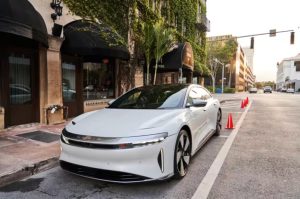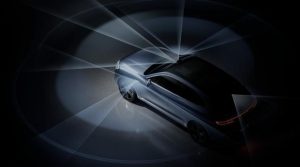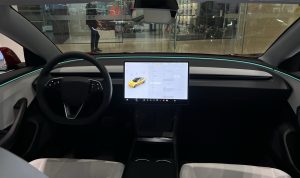Xiaomi’s Entry into the Electric Vehicle Market: A Game-Changing Move by Lei Jun
11 min read
Shifting the Paradigm with a Focus on Technology and Innovation
“Xiaomi’s goal for its electric vehicles is to rival Porsche and Tesla, creating the dream car for the new era of the automotive industry – a vehicle that is stylish, comfortable, safe, and a smart mobile space.” On December 28, the long-awaited Xiaomi Automotive Technology Conference took place as scheduled. Lei Jun, dressed in a dark gray suit, unveiled Xiaomi’s technological advancements in areas such as motors, batteries, die-casting, intelligent driving, and smart cabins.
While Lei Jun had previously stated on December 25, “This time we’re only revealing technology, not products,” the excitement from the public remained unabated.
From the official launch of Xiaomi’s automotive social media accounts on December 24 to the simultaneous Weibo announcements by Xiaomi Corporation and Xiaomi Automotive about the conference time, and Lei Jun’s consecutive Weibo posts answering questions to build anticipation—Xiaomi’s past week was filled with activities.
Prior to this, NIO unveiled its most expensive mass-produced car, the ET9, Huawei officially launched the Wanjie M9, and Jikexing released the 007. Following this, XPeng will soon launch its first MPV, the XPeng X9. Xiaomi’s entry into the field of electric vehicles came late after the stars of the two generations of new car makers, indicating the start of an intense competition.
Lei Jun, making his final entrepreneurial bet with a focus on dignity, is on the verge of success or failure. However, Lei Jun seems to be somewhat retreating while high-profile “saluting” to Wei Xiaoli, BYD, and Huawei before the conference. This conveys a subtle signal that, perhaps, in this limited game, Lei Jun wants to play an infinite game.
“Revealing Technology, Not Products” “We plan to spend 15-20 years striving to become one of China’s top five automakers, contributing to the rise of China’s automotive industry.” Before the official start of the conference, Lei Jun made this bold statement.
James P. Carse’s book “Finite and Infinite Games” illustrates two types of “games” in the world: finite games and infinite games. A finite game is played within boundaries, while an infinite game is played with the boundaries themselves. The focus of the former is on winning or losing, while the key to the latter is to involve more players in the game itself, ensuring the game’s continuation.
From the prelude to the Xiaomi Automotive Technology Conference, it seems that Xiaomi and Lei Jun are hinting at another possibility. Despite the intense speculation about this latecomer to the automotive track, with some betting on it becoming a disruptive “catfish” and others thinking it’s a wasted effort to catch up late, Xiaomi and Lei Jun appear to be implying a different narrative. Even though the competition in this track is fierce, and the “cake” is limited, they want to find an infinite game within it.
The Xiaomi super motor with a speed of 27,200 rpm, the Xiaomi CTB integrated battery, the 9,100-ton Xiaomi super die-casting, Xiaomi Titan alloy, end-to-end perception decision-making model, Snapdragon 8295 cabin chip, and Penglai OS… Technical data was the key focus of this conference, with the word “industry” following each data point. Lei Jun admitted, “This is what we’ve done in 1,000 days.”
It’s easy to imagine that these technologies require not only time but also funding. According to financial reports, in the third quarter of 2023, the expenses for Xiaomi’s innovative businesses, including smart electric vehicles, amounted to 1.7 billion yuan. At the conference, Lei Jun stated that Xiaomi’s initial investment in smart driving business was 3.3 billion yuan and has been increased to 4.2 billion yuan.
“Xiaomi Automotive will completely redefine the technological stack of the automotive industry. This will be a significant leap in the technological domain of the automotive industry.” In fact, two days before the conference, Lei Jun, the founder, chairman, and CEO of Xiaomi Group, had already released a Weibo post to hype up Xiaomi’s technology conference, stating that this conference would showcase the culmination of Xiaomi’s 13 years of technological accumulation.
While competitors were unveiling new products, Xiaomi Automotive broke the norm by “revealing technology, not products.” Whether in the prelude or the content of the conference, Xiaomi Automotive made “technology,” “automotive industry,” and “ecosystem” the keywords. Lei Jun, in particular, paid high-profile “tribute” to other players on the field, revealing a subtle signal that, perhaps, in this game, the process is more important than the outcome.
However, it’s challenging to say whether this mindset is a proactive choice or a forced one. After all, regardless of the game you want to play, you first need to be “present” and make others see you. Xiaomi Automotive entered the scene too late, and the options left for it on the field are not many. Now, taking a step back to move forward, trying to find an infinite game in a limited game, can be considered a clever move.
Nevertheless, after showcasing the core technology, Lei Jun changed into a light gray suit and brought the product Xiaomi SU7 to the stage, stating that it is a “pre-release conference for Xiaomi Automotive products.” It seems that Lei Jun’s game mentality is still somewhat undecided.
The Confidence to Enter the Arena In fact, while most new players in the automotive industry adopt OEM or acquisition models to enter the market, Lei Jun and Xiaomi, from the decision to “build their own cars” and aiming to build C-class cars, chose the challenging path.
Earlier, Lei Jun wrote on his Weibo, “In today’s automotive industry, it is indeed not difficult to assemble a car. Just find a benchmark car, reverse engineer it, change the appearance, and you can complete it quickly. But now, with hundreds of new cars released in the market every year, does Xiaomi need to assemble one more? So, when the Xiaomi Automotive team was just formed, we spent three days and nights discussing a simple question: If you join Xiaomi, what kind of car do you want to build?”
In an interview, Lei Jun revealed that the first car involved 3,400 engineers, with a total R&D investment exceeding 10 billion yuan, more than ten times the investment. “Anyway, I approached it with a ‘must-win’ mentality.”
Lei Jun’s confidence is undoubtedly related to his car-building team. In his Weibo, he wrote that when facing a long journey, the first thing is to find a group of like-minded people. “In a very short time, we received tens of thousands of resumes. In a short time, a group of outstanding talents from all over the industry gathered under the Xiaomi Automotive banner.”
Looking at the internal team, Xiaomi Automotive’s executive team includes both industry veterans and Xiaomi old-timers. The internal executive team includes Yu Liguo, who served as the head of the strategic planning department of Beijing Automotive Group, a member of the Party Committee of Beijing New Energy, and the executive deputy general manager of Beijing New Energy. He also served as the chairman of Blue Valley Smart Energy and the president of the ARCFOX business unit. Other key figures include Hong Feng and Lu Weibing, among other Xiaomi veterans.
Additionally, according to “Qujie Business,” Huang Zhenyu, who joined Xiaomi from global supplier Magna as the vice president of Magna China, took over as the general manager of the supply chain department, replacing Li Xiaoshuang, who then became the general manager of Xiaomi Automotive’s marketing department. Hu Zhengnan, the former dean of Geely Research Institute, became a senior consultant for Xiaomi Automotive, and the exterior design of Xiaomi Automotive was done by Li Tianyuan, a former exterior designer of the BMW iX model.
As for Xiaomi Automotive’s suppliers, they are familiar faces in the new energy vehicle race. According to the information filed with the Ministry of Industry and Information Technology, Xiaomi SU7 and SU7 Max are equipped with NCM lithium-ion batteries from Ningde Times, LFP lithium-ion batteries from BYD Fudi, and motors from Huichuan Power and Unite Automotive Electronics.
Inevitable Pricing Dilemma While technology is crucial, speculation about pricing has been a hot topic in Xiaomi’s Weibo comments. From three years ago, when Xiaomi officially announced its entry into smart electric vehicles, to the pre-conference hype for Xiaomi Automotive, pricing has been one of the most discussed topics in the industry.
Even Xiaomi Automotive’s “Mr. Key” Hu Zhengnan caused interpretations when he posted on Weibo on December 22: “Winter solstice, people in the north eat dumplings, people in the south eat tangyuan. Let’s go with both, and let’s not guess the price.” Some netizens interpreted it as “indicating that Xiaomi Automotive will release two models, with 17 dumplings suggesting a starting price of 17,000 yuan, and 30 tangyuan suggesting a top-end price of 30,000 yuan.”
Numerous self-media outlets have repeatedly made predictions, ranging from “starting at 19,000 yuan” to “it will exceed 30,000 yuan, with the high-end version approaching 40,000 yuan,” and then to “definitely not less than 20,000 yuan.” It can be said that opinions vary.
During the pre-conference hype, Lei Jun stated in response to questions, “About pricing, we haven’t made a final decision yet. However, Xiaomi SU7 is indeed a bit expensive, but please believe that it is ‘expensive for a reason.'”
The delayed pricing decision is undoubtedly a challenge. Especially when Xiaomi Automotive chose the “difficult bone” of the C-class car market, and information about the car’s body was frequently leaked. Phrases like “the first Porsche for young people” attracted much attention. Setting the price of the first car means defining the brand image and positioning, and also indicates whether Lei Jun wants to “win” or “allow the game to continue infinitely.”
Recalling Xiaomi’s growth path, it is well-known that Xiaomi’s essence was once about cost-effectiveness, thin profit margins, and being a price killer. From “the first smartphone for young people” to “the first TV for young people” and “the first two-wheeled balance scooter for young people,” this seemed to be Xiaomi’s inherent strategy, and it worked well.
Given this background, Lei Jun had previously initiated a vote on Weibo about Xiaomi Automotive’s pricing. Nearly 20,000 people participated, and those who chose under 100,000 yuan were the majority, followed by those in the 100,000-150,000 yuan range.
However, in the new energy vehicle arena, when Xiaomi Automotive entered late, maintaining the “cost-effectiveness” label might not be a good idea.
Firstly, if the initial positioning is at a mid-to-low-end price, once consumer expectations solidify, it will be challenging to change the brand image later.
But more importantly, from the perspective of finite and infinite games, if Xiaomi Automotive relies on low prices again to gain market share, it might easily fall back into the rules of “finite games.” It is evident that finite games are not a favorable choice for Xiaomi Automotive because, despite the inevitable losses for new car makers, as the competition intensifies, there is not much time left for Xiaomi Automotive to “stumble” if it wants to “win.”
So when Lei Jun frankly said, “It is indeed a bit expensive,” it might break some “Mi fans'” expectations. However, this time, Lei Jun and Xiaomi are not willing to be industry price killers anymore. They want to play a game that breaks boundaries.
However, to break away from the “cost-effectiveness” label, take a new path in the automotive business, and target the mid-to-high-end market from the very beginning, it might seem somewhat risky. After all, in 2023, strong product capabilities coupled with low prices have become the mainstream in the market. The most recent and direct competition is that Jikexing 007 directly lowered the price of its pure electric sedan to 210,000 yuan. Despite having a more advanced electrical architecture than Jikexing 001, the price is 100,000 yuan cheaper.
While major car companies are “tacitly” biting the bullet in one price war after another, if Xiaomi Automotive doesn’t “go all out” in terms of pricing, it might be challenging to rely solely on technology to stand out. Convincing the outside world that there is a “reason for the high price” is not as easy as Xiaomi Automotive might think.
Seeking Its Own Game is No Easy Task “The goal of Xiaomi Automotive is to enter the first echelon of the autonomous driving industry by 2024,” Lei Jun declared harshly in August 2022 during the annual speech. At that time, Lei Jun’s mindset and goals seemed more like playing a finite game—determining the winner or loser.
A little over a year later, Lei Jun’s goals appear to be longer-term and more ambitious, and his game mentality seems to have quietly changed. Whether this goal can be achieved or not, Xiaomi Automotive may become the “catfish” in the automotive industry in 2024.
Let’s take a look at the current situation in the electric vehicle arena. In the soon-to-pass 2023, the first generation of new car makers is at a crossroads. NIO, originally the most advanced among the three major new car makers in the new energy vehicle track and with the highest sales, began to show signs of decline since 2022. In 2023, it was overtaken by Xpeng in terms of sales and market value. NIO, which has been in the car-making business for ten years, seems to be facing a mid-life crisis.
As for Xiaopeng, numerous changes have taken place since the beginning of the year. For instance, in January, it officially announced that Wang Fengying, the former general manager of Great Wall Motors, would serve as the president, taking full responsibility for the company’s product planning, product matrix, and sales system. The reform and adjustment of Xiaopeng Motors seem to be showing initial results, with a cumulative delivery of 121,486 vehicles by the end of November 2023. Although it did not reach the target of 200,000 vehicles set at the beginning of the year, it has already exceeded the total cumulative delivery for the entire year of 2022. However, like NIO, losses remain a significant challenge for Xiaopeng.
Representing players in the era of Automobile 3.0, Huawei dominated the headlines in 2023, repeatedly grabbing attention. Star Era Meizu also began to make its mark.
The data is even more illustrative. According to the data disclosed by Yu Chengdong at the press conference, since its launch on September 12, the new M7, a collaboration between Huawei and Saic Motor’s Qijian, has exceeded 100,000 orders. The Zhijie series, a collaboration with Chery, has also achieved good results. The Zhijie S7 had already surpassed 20,000 pre-orders by the end of November. Meizu, in collaboration with Star Era, launched Flyme Auto, a car-specific adaptation of its operating system, which was installed in the Lynk & Co 08, achieving sales of over 12,000 units in just 54 days.
Recently, Huawei has made continuous moves, signing an agreement with Changan Automobile to establish a joint venture, with Huawei holding a 60% stake. This means that even if Lei Jun wants to find his own game on the field, it is hard to ignore that the rules of the game have been set, and this is a game destined to be “finite.”
Therefore, when Xiaomi’s car officially debuts, it is bound to disrupt the market landscape. After all, the process of elimination is ongoing. According to media reports, in 2018, there were over 487 electric vehicle manufacturers in China. Still, by 2023, according to Xiaopeng Motors CEO He Xiaopeng, there are only about 50 new forces in the electric vehicle industry operating normally. In the past year, new players in the car manufacturing sector, such as Weimar Motors, Horizon Robotics, NIUTRON, Hengchi, Ai Chi, and Redding, have been successively exposed for poor business operations.
In fact, before Xiaomi’s car technology launch event, NIO unveiled its first executive flagship luxury car, the ET9, at the annual NIO Day. Huawei officially released the Wanjie M9, and Jike announced the 007. Following these, Xiaopeng is set to launch its first MPV, the Xiaopeng X9. This is, in essence, a condensed representation of an intense battle. Not to mention, from late 2023 to the first half of 2024, there will be a wave of new pure electric sedans entering the market. A simple count reveals that from late 2023 to early 2024, there will be eight new models of similar sedans entering the market.
Therefore, Lei Jun’s first step in breaking boundaries and rules on the field may be to keep Xiaomi’s car “on the field” for a longer duration. Whether Xiaomi’s car will face challenges from all sides or emerge as a latecomer taking the lead will likely be determined in the coming year.




